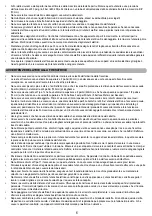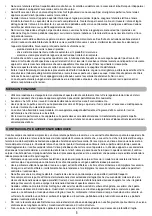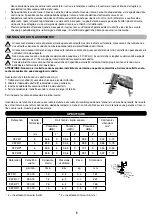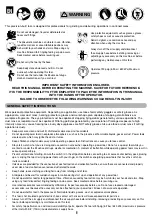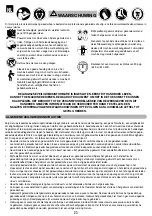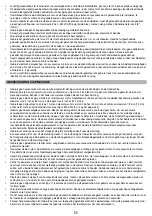
10
•
Do not run the power tool while carrying it at your side. Accidental contact with the spinning accessory could snag your clothing,
pulling the accessory into your body.
•
Do not grind with the side of a cut-off wheel. Abrasive cut-off wheels are intended for peripheral grinding, side forces applied to
these wheels may cause them to shatter.
•
When wheel is pinched, snagged or when interrupting a cut for any reason, switch off the power tool and hold the power tool
motionless until the wheel comes to a complete stop. Never attempt to remove the cut-off wheel from the cut while the wheel is in
motion, otherwise kickback may occur. Investigate and take corrective action to eliminate the cause of wheel binding.
•
Do not restart the cutting operation in the workpiece. Let the wheel reach full speed and carefully reenter the cut. The wheel may
bind, walk up or kickback if the power tool is restarted in the workpiece.
•
Some dust created by power sanding, sawing, grinding, drilling, and other construction activities contains chemicals known to
the State of California to cause cancer, birth defects or other reproductive harm. Some examples of these chemicals are:
- lead from lead-based paints,
- crystalline silica from bricks and cement and other masonry products, and
- arsenic and chromium from chemically-treated lumber.
your risk from these exposures varies, depending on how often you do this type of work. To reduce your exposure to these
chemicals: work in a well ventilated area, and work with approved safety equipment, such as those dust masks that are specially
designed to filter out microscopic particles.
•
Do not use the tool if the trigger does not turn the tool on or off.
•
Avoid prolonged contact with dust from power sanding, sawing, grinding, drilling, and other construction activities. Wear
protective clothing and wash exposed areas with soap and water. Allowing dust to get into your mouth, eyes, or lay on the skin
may promote absorption of harmful chemicals.
•
Use of this tool can generate and/or disperse dust, which may cause serious and permanent respiratory or other injury.
GETTING STARTED
•
Always operate, inspect and maintain this tool in accordance with all regulations (local, state, federal and country) that
may apply to hand-held / hand-operated pneumatic tools.
•
Be sure all hoses and fittings are the correct size and are tightly secured.
•
Always use clean, dry air at 90 psig maximum air pressure. Dust, corrosive fumes and/or excessive moisture can ruin
the motor of an air tool.
•
The use of a hose whip is recommended. A coupler connected directly to the air inlet increases tool bulk and decreases
tool maneuverability.
•
For maximum performance, the coupler on the wall should be the next size larger than the coupler used on the tool.
The coupler closest to the tool should not be less than the proper air supply hose size.
KICKBACK AND RELATED WARNINGS
kickback is a sudden reaction to a pinched or snagged rotating wheel, sanding pad, brush or any other accessory. Pinching
or snagging causes rapid stalling of the rotating accessory which in turn causes the uncontrolled power tool to be forced in
the direction opposite of the accessory’s rotation. For example, if an abrasive wheel is snagged or pinched by the workpiece,
the edge of the wheel that is entering into the pinch point can dig into the surface of the material causing the wheel to
climb out or kick out. The wheel may either jump toward or away from the operator, depending on direction of the wheel’s
movement at the point of pinching. Abrasive wheels may also break under these conditions. kickback is the result of tool
misuse and/or incorrect operating procedures or conditions and can be avoided by taking proper precautions as given
below:
•
Maintain a firm grip on the power tool and position your body and arm to allow you to resist kickback forces. The
operator can control kickback forces, if proper precautions are taken.
•
Use special care when working corners, sharp edges etc. Avoid bouncing and snagging the accessory. Corners, sharp
edges or bouncing have a tendency to snag the rotating accessory and cause loss of control or kickback.
•
Do not attach a toothed saw blade. Such blades create frequent kickback and loss of control.
•
Always feed the bit into the material in the same direction as the cutting edge is exiting from the material (which is the
same direction as the chips are thrown). Feeding the tool in the wrong direction causes the cutting edge of the bit to
climb out of the work and pull the tool in the direction of this feed.
•
When using rotary files, cut-off wheels, high-speed cutters or tungsten carbide cutters, always have the work securely
clamped. These wheels will grab if they become slightly canted in the groove, and can kickback. When a cut-off wheel
grabs, the wheel itself usually breaks. When a rotary file, high-speed cutter or tungsten carbide cutter grabs, it may
jump from the groove and you could lose control of the tool.
•
For threaded abrasive cones and plugs use only undamaged wheel mandrels with an unrelieved shoulder flange that are of correct
size and length. Proper mandrels will reduce the possibility of breakage.
•
Do not “jam” the cut-off wheel or apply excessive pressure. Do not attempt to make an excessive depth of cut.
Overstressing the wheel increases the loading and susceptibility to twisting or snagging of the wheel in the cut and the
possibility of kickback or wheel breakage.
Summary of Contents for 922 B1
Page 118: ...118 NOTA ...
Page 119: ...119 NOTA ...




